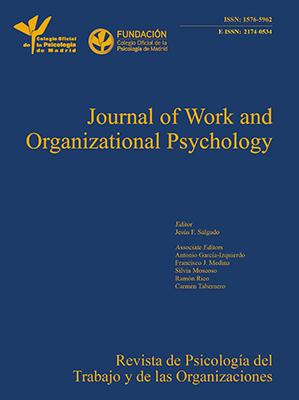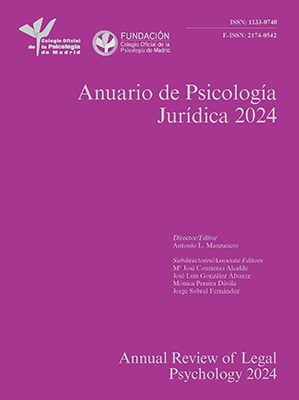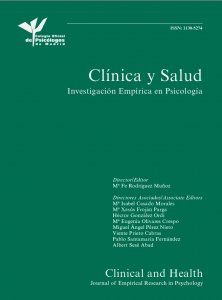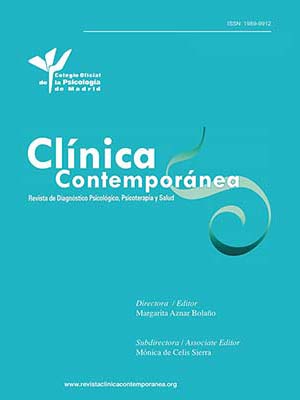
Academic Stress, Evaluation Anxiety, and University Dropout Intention: Mediating and Moderating Roles for Resilience
[El estrés académico, la ansiedad ante la evaluación y la intención de dejar la universidad: los roles mediador y moderador de la resiliencia]
Elena Blanco, Ana B. Bernardo, Ellián Tuero, and José C. Núñez
Universidad de Oviedo, Spain
https://doi.org/10.5093/psed2025a13
Received 28 November 2024, Accepted 3 February 2025
Abstract
Resilience is a significant factor in explaining university dropout rates. Despite research on its relationship with dropout, little attention has been given to its role alongside academic stress. This study aims to analyse how resilience mediates and moderates the relationship between academic stress/evaluation anxiety and university dropout intention. A total of 1,505 students from a Spanish university participated. The mediation study demonstrated that resilience partially mediated the relationship between academic stress and dropout intention and fully mediated the relationship between evaluation anxiety and dropout intention. The results of the moderation study indicated that resilience moderated both variables’ influence on dropout. The mediation model explained 7% of the variance in the dropout intention, while the moderation model explained 14%. It can be concluded that academic stress, evaluation anxiety and resilience are significant variables in the university dropout intention, with resilience playing both a mediating and a moderating role.
Resumen
La resiliencia aparece como una variable importante en la explicación del abandono universitario. Sin embargo, a pesar de la literatura existente, son escasas las investigaciones que ahondan en el rol que juega en modelos más amplios que contemplan la influencia del estrés académico. El objetivo del estudio es analizar el papel mediador y moderador de la resiliencia en la relación entre el estrés académico/ansiedad ante la evaluación y la intención de dejar la universidad. La muestra consta de 1,505 estudiantes de una universidad española, analizándose modelos de mediación y moderación. En el estudio de la mediación la resiliencia media parcialmente la relación entre el estrés académico y la intención de abandono y media totalmente la relación entre la ansiedad ante la evaluación y la intención de abandono. En el de moderación la resiliencia modera la influencia de ambas variables sobre el abandono de la universidad. Asimismo, el porcentaje de varianza explicada de la intención de abandono por el modelo de mediación es el 7% y el del modelo de moderación el 14%. Se concluye que el estrés académico, la ansiedad ante la evaluación y la resiliencia son variables significativas a la hora de plantearse dejar la universidad, pudiendo mostrar la resiliencia tanto un rol mediador como moderador.
Palabras clave
Abandono universitario, Estrés académico, Ansiedad ante la evaluación, Resiliencia, Moderación, MediaciónKeywords
University dropout, Academic stress, Evaluation anxiety, Resilience, Moderation, MediationCite this article as: Blanco, E., Bernardo, A. B., Tuero, E., and Núñez, J. C. (2025). Academic Stress, Evaluation Anxiety, and University Dropout Intention: Mediating and Moderating Roles for Resilience. PsicologĂa Educativa, 31(2), 101 - 109. https://doi.org/10.5093/psed2025a13
Correspondence: bernardoana@uniovi.es (A. B. Bernardo)., Correspondence: bernardoana@uniovi.es (A. B. Bernardo).The concept of the university has evolved over time, a process that is ongoing in the present day because of political, economic, and social changes, including the implementation of the European Higher Education Area (Alonso-García et al., 2018). These changes have led to increased numbers of university students, resulting in a more heterogeneous student population, with an increasing amount of university dropout and the reasons for it (United Nations, 2022). In Europe, the rate of university dropout varies significantly, ranging from 10% in countries like Switzerland to 30% in countries such as Italy or Spain (Ministerio de Ciencia, Innovación y Universidades, 2025; OCDE, 2023). These high dropout rates translate into a waste of resources, both for students and their families, as well as for universities and society (Améstica-Rivas et al., 2021). They may also lead to a shortage of highly qualified university graduates, significantly affecting the labour market over the coming decades (Behr et al., 2020). University dropout is a widespread term used to refer to students who leave their course of study without obtaining a degree (Larsen et al., 2013). One reason why it is difficult to study lies in the fact that it is something reflecting a complex decision-making process, where several conditions and problems are taken into account, with many variables needed to explain it (Bäulke et al., 2022). Accordingly, some comprehensive models of university dropout, most notably Bean and Eaton’s (2001), underscore the significance of psychological processes and personal aptitudes in adapting to the institutional environment and developing a commitment to studies. In this scenario, resilience emerges as a key concept in addressing university dropout (Pertegal-Felices et al., 2022), relating to variables such as academic stress, which has a significant impact on students’ well-being and performance (Ayala & Manzano, 2018; López-Aguilar et al., 2023). Despite the importance of resilience in this context, there are some gaps in our understanding of how it is involved in these processes and its relationship with the intention to drop out. Although some studies have identified resilience as a factor that may influence students’ ability to cope with academic stress (Choi et al., 2023; Galindo-Domínguez et al., 2020), further exploration of the specific mechanisms through which resilience may mitigate the negative effects of stressors on dropout is still lacking. This lack of clarity in understanding the role of resilience in academic stress processes is a gap in the research (Durso et al., 2021). In this regard, the present study seeks to address this gap by exploring the role of resilience, taking a holistic approach that examines both its mediating and moderating influence to provide a more comprehensive, detailed view of how resilience can play the role of a protective factor against dropout. Academic Stressors at University Within the institutional context, a set of stimuli can be identified that students can experience as “academic stressors”, which have a significant impact on their well-being and academic performance and consequently on their intention to drop out of their course of study (Muñoz, 2004; Quintero et al., 2020). These stressors are “those factors or stimuli in the educational environment that put pressure on the student in some way” (Muñoz, 2004, p. 55), influencing the teaching-learning process. For example, some studies have found that students can perceive stimuli such as teaching staff’s methodological deficiencies, academic overload, class structure, and assessments as stressful (Adegboyega, 2020; Avalos & Trujillo, 2021; Morales-Dechoudens et al., 2019; Silva et al., 2019), which may lead them to experience a certain level of stress and/or anxiety (Koppenborg et al., 2022; Zhu et al., 2021). Stress can be understood as an imbalance between the demands of the environment and the resources available to the individual to cope with these demands (Lazarus et al., 1985; Quintero et al., 2020). According to this definition, students seeing academic stimuli as stressful produces a situation of imbalance, understood as “academic stress” (Chávez et al., 2019). Students who drop out of university tend to have high academic stress scores (Cadariu & Rad, 2023; Suárez-Montes & Díaz-Subieta, 2015). Moreover, the level of stress among students is known to be high, as exploratory studies have shown that approximately 30% of students think that they are very stressed and another 30% are moderately stressed (Mayya et al., 2023; Vega-Martínez et al., 2023). These findings suggest that, given that university dropout rates are not so high, there are students with high levels of academic stress who continue with their studies. Consequently, there is a growing interest in studying the role played by certain variables in academic stress processes (García-Martínez et al., 2023; Smithikrai & Smithikrai, 2024), though to date this has not been considered in the study of university dropout. Anxiety can be understood as a behavioural, physiological, affective, and cognitive response to an uncontrollable situation that is considered aversive or threatening (Clark & Beck, 2012). Exams and assessments are among the stimuli considered threatening that can trigger higher levels of anxiety (Fernández-Castillo & Caurcel, 2015). Therefore, within the educational context it is common to use the term “evaluation anxiety”, or test anxiety, for a more-anxious-than-usual reaction shown by students in situations of academic assessment (Chust-Hernández et al., 2019; Sansgiry & Sail, 2006). As with academic stress, a large proportion of students experience high evaluation anxiety, with figures ranging from 30% to 50% (Gerwing et al., 2015; Jarso et al., 2024). This anxiety can affect students’ performance (Fernández-Castillo & Caurcel, 2015; Putwain & Symes, 2018) and, consequently, their intention to drop out (Baalmann, 2023). However, the impact of evaluation anxiety on university dropout intention has not received much attention. The current study examines academic stress and evaluation anxiety concurrently to gain a more comprehensive and accurate understanding of their impact on university students, with a particular focus on their intention to leave their studies. Previous research has analysed the relationship between academic stress, evaluation anxiety, and other variables, such as academic performance (Stankovska et al., 2018), due to the high correlation observed between academic stress and evaluation anxiety (Zheng et al., 2023). Resilience in University Students It is well known that the same stressor can be experienced in different ways—with different consequences—due to the existence of a set of variables that moderate or mediate the relationship between academic stressors and their effects (Muñoz, 2004; Okechukwu et al., 2022). From this set of variables, the present study focuses on resilience. This approach aims to make meaningful contributions to the mechanisms by which student stress and anxiety can be relieved, buffering their negative consequences, in this case, on university dropout. Resilience refers to a dynamic process operating in situations of adversity, allowing people to overcome or adapt to them (Aguilar-Maldonado et al., 2019). Within the educational context, it refers to students’ ability to overcome stressful situations and develop suitable social, academic, and vocational competencies (Acevedo & Mondragón, 2005). Consequently, the capacity for resilience represents a critical aspect in enabling students to cope effectively with the challenges presented by university life. This is reflected in the finding of numerous authors, such as Nino et al. (2024) and Van Wyk et al. (2022), who have found that students exhibiting higher levels of resilience demonstrate better academic performance. Furthermore, resilience has demonstrated a considerable potential as a mediating and moderating variable (Schoeps et al., 2023). On the one hand, Choi et al. (2023) and Okechukwu et al. (2022) found that resilience is a moderator since it reduces the damaging effects of students’ academic stress on their adaptation to the university context. On the other hand, Massoud et al. (2023) and Mateos et al. (2021) found that resilience mediates the indirect relationship between the perception of certain stressors in the university context and students’ academic performance. In a more general sense, the meta-analysis by Mulati and Purwandari (2022) suggests a negative correlation between resilience and academic stress, with higher levels of resilience corresponding to lower levels of academic stress and vice versa. The results demonstrate that resilience is a crucial variable in higher education. While the preceding research did not examine university dropout alongside stress and resilience, this represents an opportunity to expand our understanding within this field of study. Moreover, authors such as Pertegal-Felices et al. (2022) noted that resilience can help students to overcome the stressors present in higher education, resulting in student retention. In this perspective, the Academic Resilience Model proposed by Durso et al. (2021) posits that resilience is the outcome of a multifaceted interaction among the student, the academic environment, and the external context. Consequently, adversities present at these levels (individual, academic and external)—which have the capacity to generate elevated levels of academic stress—can compromise academic progress. Conversely, personal skills, such as resilience, have the potential to buffer the impact of these adversities. This suggests that resilience may act as a moderating or mediating factor in the relationship between academic stressors and the intention to drop out of higher education, potentially mitigating the impact of academic stress or evaluation anxiety. Aim and Hypotheses The present study aims to examine the role resilience plays in the relationship between academic stress/evaluation anxiety and the intention to drop out. To this end, two models are proposed, the first one outlining a partial mediating role (see Figure 1) and the second one a moderating role (see Figure 2). These models specify that: Hypothesis 1: Academic stress is directly related to university dropout intention (the higher the level of academic stress, the greater the intention to drop out). Hypothesis 2: Evaluation anxiety is directly related to university dropout intention (the higher the evaluation anxiety, the greater the intention to drop out). Hypothesis 3 (Model 1): Resilience partially mediates the relationship between academic stress and evaluation anxiety and university dropout intention. Hypothesis 4 (Model 2): Resilience moderates the relationship between academic stress and evaluation anxiety and university dropout intention, attenuating the effect of academic stress and evaluation anxiety on the intention to drop out. Participants The participants were 1,505 first- and second-year students (60.5% and 39.5%, respectively) from a public university in northern Spain. The majority were female (64.8%), ranging from 17 to 64 years old, with a mean of 19.44 (SD = 3.71). To achieve greater representativeness, a diverse sample was sought to include students from different degree programs belonging to different fields of study: Educational Sciences (26.7%), Health Sciences (24.5%), Social and Legal Sciences (15.9%), Arts and Humanities (12.4%), Sciences (10.6%), and Engineering (10%). A third of the participants (n = 504, 33.5%) expressed an intention to drop out of their course. However, the intention to transfer (n = 295, 58.53%), which involves changing degree course or university, was more prevalent than the intention to leave university altogether (n = 209, 41.47%). Instruments An ad hoc questionnaire was designed to collect information on personal and socio-demographic variables (such as gender, age, and degree, among others), university dropout intention, academic stress, evaluation anxiety, and resilience. University Dropout Intention Drop out intention was measured by two items from the Early University Dropout Intention Questionnaire -EUDIQ-R- (Bernardo et al., 2022): “Have you ever thought about dropping out of your current course of study?” and “If yes, tick the options that would make you drop out, i.e., change university, change degree, change to non-university studies, or drop out completely.” This choice of items aligns with previous research that has demonstrated the effectiveness of this format for assessing university dropout intention (Campos-Muñoz et al., 2024; Peña-Vázquez et al., 2023). Academic Stress This was measured with the Academic Stressors Scale -E-CEA (Cabanach et al., 2016), consisting of 54 items divided into 8 factors: 1) teacher methodological deficiencies, 2) student overload, 3) beliefs about performance, 4) public speaking, 5) negative social climate, 6) content value beliefs, 7) exams, and 8) participation difficulties, with responses given on a 5-point Likert scale, from 1 = never to 5 = always. Reliability in this study is É‘ = .97 (IC 95% [.96, .97]) and ω = .97 (IC 95% [.96, .97]). Evaluation Anxiety This was measured with the Brief Scale of Academic Evaluation Anxiety -EBAEA-3- (Frías-Navarro et al., 2020), consisting of 3 items to assess evaluation anxiety, 1 item for state anxiety and 1 item for trait anxiety. Responses are given on a 10-point Likert scale, from 1 = not anxious to 10 = very anxious. Reliability in this study is É‘ = .93 (IC 95% [.92, .93]) and ω = .93 (IC 95% [.92, .93]). Resilience Resilience was measured with the Connor-Davidson Resilience Scale in its reduced version—CD-RISC-10 (Connor & Davidson, 2003) adapted to Spanish by Notario-Pacheco et al. (2011). It consists of 10 items with responses given on a 5-point Likert scale, from 1 = strongly disagree to 5 = cursivastrongly agree.cursiva Reliability in this study is É‘ = .80 (IC 95% [.78, .81]) and ω = .80 (IC 95% [.79, .82]). Procedure After obtaining approval from the Ethics Committee of the university involved in the study, the first- and second-year teaching staff at the university were asked to collaborate. These academic years were selected for the study due to their association with higher university dropout rates. A non-probabilistic convenience sampling method was employed, selecting teachers based on their availability. Teachers who agreed gave up class time so that the students could respond to the scale items during class hours. The data was gathered between the period of November to February, which was near the deadlines for submission of assignments and the evaluations being conducted. The questionnaire was accompanied by an informed consent form and the researchers explained the objectives of the research in the classrooms, as well as the principles of confidentiality and anonymity. Data Analysis The mediation and moderation models were analysed with the help of SPSS AMOS 22 (Arbuckle, 2013). Before examining model fit, the psychometric properties of the variables included in the analyses were analysed (e.g. descriptive statistics, properties of the distribution of measures). According to the criteria established by Gravetter and Wallnau (2014), the distribution of the variable scores could be considered normal (both skewness and kurtosis between ± 1). In addition, the expectation-maximization algorithm was used with auxiliary variables offered by the SPSS 26 program. Fernández-Alonso et al. (2012) showed that this two-stage procedure is the one that best recovers lost data when, as in this case, the loss size is small and the bias moderate. The fit of the models was assessed according to the typically used criteria: chi-square, RMR, GFI, AGFI, AGFI, TLI, CFI, RMSEA. There is evidence of a good fit when χ2 has p > .05, RMR < .05, GFI, AGFI and TLI ≥ .90, CFI ≥ .95, and RMSEA ≤ .06. When the proposed model needed re-specifying, selection of the best model was based on the AIC and BIC statistics (the best model is the one with lower values for AIC and BIC). The effect sizes of the corresponding regression coefficients were evaluated using the f2 criterion (f2 ≥ .02 small effect, f2 ≥ .15 medium effect, f2 ≥ .35 large effect). Descriptive statistics and the correlation matrix are provided in Table 1. The correlations indicate that academic stress (“stress”) and evaluation anxiety (“anxiety”) were positively and significantly related (p < .001) to university dropout intention (the higher the academic stress and evaluation anxiety, the higher the university dropout intention, and vice versa), and resilience was negatively and significantly related (p < .001) to academic stress, evaluation anxiety, and university dropout intention (the higher the stress and anxiety, the lower the resilience and the higher the university dropout intention). The variables show a normal distribution. Mediation Study Data from the resilience mediation study indicate that the fit of the total mediation model was not acceptable, χ2(2) = 56.676, RMR = .935, GFI = .982, AGFI = .909, TLI = .888, CFI = .943, RMSEA = .135, AIC = 72.676, BIC = 115.208. Reviewing the residuals and modification indices, we found that model fit improved if the direct effect of stress on university dropout intention is introduced, Δχ2(1) = 49.856, p < .001, ΔAIC = 47.856, ΔBIC = 42.539. With no further alternative effects to consider, with this modification, the model fit was adequate, χ2(1) = 6.820, RMR = .048, GFI = .998, AGFI = .977, TLI = .976, CFI = .996, RMSEA = .060, AIC = 24.820, BIC = 72.669. Examining the relationships in this final model showed that (a) academic stress and evaluation anxiety were negatively and significantly related to resilience (stress: b = -.263, p < .001, f2 = .330; anxiety: b = -.232, p < .001, ƒ2 = .294), indicating that the higher the level of academic stress and evaluation anxiety, the lower the level of resilience, and vice versa; (b) resilience had a negative and statistically significant relationship with university dropout intention (b = -.116, p < .001, ƒ2 = .168), in other words, the higher the resilience, the lower the university dropout intention, and vice versa; (c) while academic stress was positively and significantly associated with university dropout intention (b = .195, p < .001, f2 = .253), evaluation anxiety was not directly associated with university dropout intention; (d) academic stress and evaluation anxiety were strongly related (r = .697); and (e) resilience significantly mediated the relationship between academic stress, evaluation anxiety, and university dropout intention. More specifically, there were statistically significant indirect effects (evaluation anxiety → resilience → university dropout intention: β = .027, p < .05, f2 = .077; academic stress → resilience → university dropout intention: β = .030, p < .05, f2 = .080, with a small effect size. Finally, the amount of variance explained for resilience was 21%, while the variance explained for university dropout intention was 7%. Figure 3 shows the direct effects and explained variance of the two dependent variables. Moderation Study The data show the moderating effects of resilience on the relationship between academic stress and evaluation anxiety and university dropout intention (stress x resilience: β = .115, p < .001, f2 = .167; anxiety x resilience: β = .075, p < .01, ƒ2 = .126), the effect sizes being medium and small, respectively. The amount of variance explained for university dropout intention was 14%. Figure 4 Graphical Representation of the Conditional Effect of Resilience on the Effect of Academic Stress on University Dropout Intention.  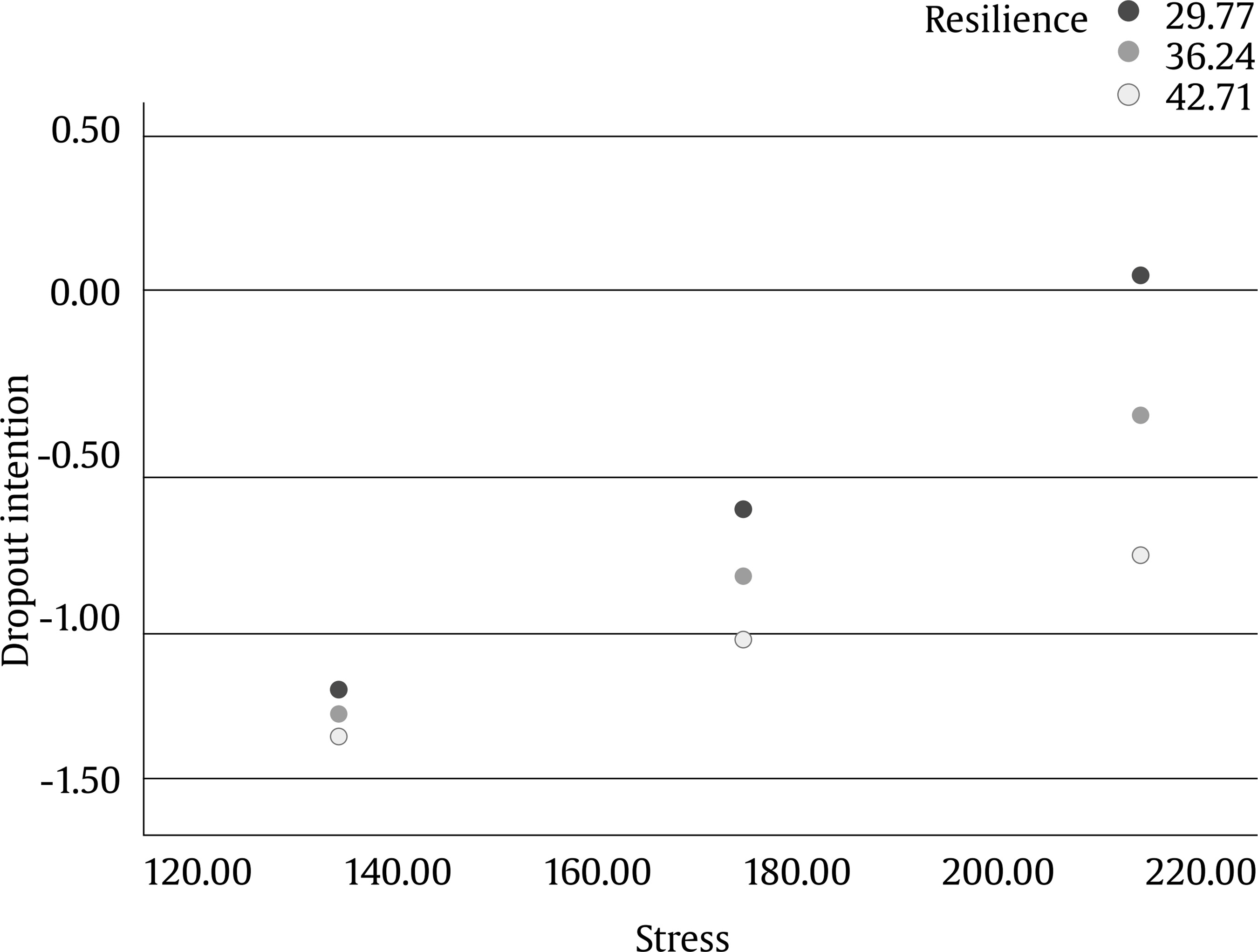 Looking at the analysis regarding the conditional effect of resilience on the effect of academic stress on university dropout intention, the results indicate that the conditional effect was statistically significant at low, medium and high levels of resilience, although the conditional effect was larger the lower the resilience (low: β = .016, p < .001, f2 = .066; medium: β = .012, p < .001, f2 = .062; high: β = .008, p < .001, f2 = .058). Regarding the conditional effect of resilience on the effect of evaluation anxiety on university dropout intention, there were only statistically significant conditional effects for low and medium levels of resilience (low: β = .014, p < .01, f2 = .064; medium: β = .027, p < .01, f2 = .077; high: β = .010, p > .05, f2 = .060). Figure 5 Graphical Representation of the Conditional Effect of Resilience on the Effect of Evaluation Anxiety on University Dropout Intention.   Data from the detailed study of the conditional effects of resilience are shown in Table 2, and Figures 4 and 5 give a graphical representation of the conditional effect of resilience. Table 2 shows, for example, that when students experience a high level of academic stress (212.89), those with a low level of resilience (29.76) have a higher tendency to consider dropping out (0.04). However, as resilience increases, this tendency decreases significantly. Students with a medium level of resilience (36.23) have a lower intention to drop out (-0.30), and students with a high level of resilience (42.71) show the lowest intention to drop out (-0.66) in this high academic stress scenario. Many studies have shown university dropout to be explained by the interaction between multiple variables (Abbas et al., 2023; Behr et al., 2020; Bernardo et al., 2022). In this scenario and taking the growing importance of resilience into account (Pertegal-Felices et al., 2022), the aim of the present study has been to analyse the mediating or moderating role played by resilience in the relationship between academic stress/evaluation anxiety and the intention to drop out. The first hypothesis of this study was that “Academic stress is directly related to university dropout intenntion.” The data allow us to accept this hypothesis, since there was direct, positive relationship between academic stress and university dropout intention, such that higher levels of academic stress were related to greater intention to drop out. This finding is consistent with other research, such as Villacorta et al.’s (2022), who also identified a positive relationship between academic stress and the intention to drop out. This is attributable to the fact that academic stress can generate a negative feedback cycle that can result in students dropping out of university. Perceived excessive workload, a competitive classroom climate, outdated curricular content, and so forth have been shown to raise feelings of frustration and dissatisfaction with studies (Park et al., 2020), which can prevent adaptation to the university context (Jardim & Soares, 2023). This, in turn, has been shown to decrease student performance, strengthening the perception of academic stress and increasing the intention to drop out of university. Similarly, the second study hypothesis was that “Evaluation anxiety is directly related to the university dropout intention.” In this case, the hypothesis cannot be accepted, since there was no direct relationship, the involvement of resilience being necessary either as a mediator or as a moderator. This contrasts with studies reporting that anxiety, measured in terms of state anxiety and trait anxiety, was related to dropout (Abbas et al., 2023; Caballero-Domínguez et al., 2020) and suggests that evaluation anxiety in isolation does not impact the approach to dropout. This may be attributable to the multifaceted nature of the decision to drop out of university, which is influenced by a multitude of academic, social, personal, and other factors (Bäulke et al., 2022; Behr et al., 2020). Consequently, the impact of test anxiety may be mitigated or amplified by other variables, such as state and/or trait anxiety. While evaluation anxiety is not directly associated with the intention to drop out, it may contribute to the development of other negative outcomes, such as poor academic performance, which in turn can increase the risk of dropout (Putwain & Symes, 2018). Likewise, we found a strong correlation between academic stress and evaluation anxiety, such that higher levels of academic stress were related to higher evaluation anxiety, and vice versa. This is consistent with the remarks of other authors, including Trigueros et al. (2020) and Zheng et al. (2023). Evidence suggests that perceiving academic demands as excessive or threatening can lead to increased evaluation anxiety, which, in turn, can exacerbate academic stress. Consequently, based on these findings, the mediating role of academic stress, evaluation anxiety, and dropout intention could be studied. On one hand, we posited two hypotheses about the role of resilience to examine its mediating (hypothesis 3) and moderating (hypothesis 4) roles. On the one hand, the results show that resilience partially mediated the relationship between academic stress and university dropout intention and fully mediated the relationship between evaluation anxiety and university dropout intention. These results are in line with other research showing resilience playing a mediating role between stress and academic performance (Massoud et al., 2023; Mateos et al., 2021). The results also reinforce resilience’s influence on the dropout (López-Aguilar, 2023) and allow for a better understanding of the underlying mechanisms. It should be noted that the model only explains 7% of the intention to drop out, but this may be because it is a multicausal event (Bäulke et al., 2022; Behr et al., 2020), meaning that a generalized picture of it would need more variables to be included. On the other hand, our data show that resilience moderated the relationship between academic stress/evaluation anxiety and university dropout intention. Again, the results are in line with other research which has highlighted the moderating role of resilience in the relationship between academic stress and university adjustment (Choi et al., 2023; Okechukwu et al., 2022). In our study, the explained variance of dropout intention amounts to 14%, twice the explanatory power of the mediation model. Therefore, resilience seems to contribute more as a moderating variable than as a mediating variable. Within the moderation model, the results indicate that the relationship between academic stress and university dropout intention is stronger when resilience is lower. That is, when students show high levels of resilience, the effect of academic stress on the intention to drop out is lower, and resilience may play as a protective factor. This helps to corroborate the Academic Resilience Model proposed by Durso et al. (2021), which suggests that student resilience is determined by personal factors (such as adaptive capacity and/or self-control) and contextual factors (such as social adaptation and family support), and acts as a protective mechanism, allowing students to overcome sources of stress, such as teaching methodology or overload, promoting academic success and student retention. Likewise, the moderating role of resilience in the relationship between evaluation anxiety and university dropout intention is significant when student resilience levels are low or medium. Furthermore, the conditional effect is greater for medium levels of resilience; when students exhibit medium levels of resilience, the effect of evaluation anxiety on intention to drop out is greater than when the level of resilience is low. This is a somewhat atypical result, since research to date suggests that higher levels of resilience allow students to cope more successfully with situations of burnout, anxiety, and stress (Devi et al., 2021; Fernández-Castillo & Fernández-Prados, 2021; León et al., 2019). However, this pattern might be explained by considering the nuanced nature of resilience. It is possible that individuals exhibiting medium levels of resilience may be in a more vulnerable state in comparison to those demonstrating extreme, low, or high levels of resilience. As stated by Southwick and Charney (2012), individuals with medium levels of resilience have the ability to successfully cope with certain challenges; however, they may be more vulnerable to stressors in comparison to individuals with high or low levels of resilience. This heightened vulnerability may offer a potential explanation for the increased impact of evaluation anxiety on the intention to drop out, particularly among students with medium levels of resilience. In addition, it may be that students with low levels of resilience are less engaged (Gaxiola & González, 2020), which may influence the way they perceive evaluation anxiety and the consequences of assessment. Nevertheless, due to the shortage of studies linking this variable to dropout, further research is essential. Practical and Theoretical Implications The findings of this study emphasise the multifaceted role of resilience in mitigating the impact of academic stress and evaluation anxiety on students’ intention to drop out. By demonstrating both mediating and moderating effect, our study highlights the significance of resilience as a protective factor and the need to enhance university students’ resilience skills (Alonso et al., 2024; Young et al., 2024). The implications of these findings extend beyond the theoretical realm, bearing significant practical implications. The findings strongly suggest that universities should prioritize the development and implementation of resilience-building interventions. Existing programs offer promising models for fostering resilience among students. For example, the “Resilience Journal” by Lohner and Aprea (2021) focuses on coping with challenges faced by university students through writing activities, while the “Cultivating our Resilience” by Herrero et al. (2019) is an online intervention based on Ryff’s wellbeing model to promote resilience and coping strategies to successfully complete university. The implementation of such interventions, which facilitate the acquisition of coping mechanisms and tools to navigate academic challenges, has the potential to enhance students’ overall well-being and mitigate the probability of dropout rates. Furthermore, the findings highlight the potential for a more nuanced understanding of the relationship between academic stress, evaluation anxiety, and dropout intention. While the present study did not find a direct relationship between evaluation anxiety and dropout intention, the moderating role of resilience suggests that the impact of evaluation anxiety may vary depending on an individual’s level of resilience. This finding is of significant theoretical relevance. The findings suggest that the relationship between evaluation anxiety and the intention to drop out is not static, but rather dynamic and influenced by individual characteristics. The multifaceted nature of resilience, encompassing cognitive, emotional, and behavioural dimensions, is indicative of its pivotal role in shaping this dynamic relationship. These findings underscore the limitations of simplistic models that focus solely on the direct impact of specific stressors, such as evaluation anxiety, on university dropout. A more comprehensive understanding of the issue requires the acknowledgement of the mediating and moderating influences of individual factors, such as resilience, and the complex interplay between these factors within the broader context of the university environment. This complexity needs further research to elucidate the intricate pathways through which academic stress, evaluation anxiety, resilience, and other relevant factors contribute to the decision to drop out of university. Despite these findings, the present study has some limitations. Firstly, although the sample was large, it was limited to one Spanish university, so the results may not be able to be extrapolated to other international contexts, where the characteristics of educational institutions and students may be different. Therefore, our results contribute to suggesting possible relationships between the variables studied (academic stress, evaluation anxiety, resilience, and university dropout intention), but further study is still needed. Secondly, the intention to drop out is studied globally without distinguishing between definitive dropout and dropout due to transfer (change of degree and/or university). However, given that some studies have found differences in the variables that affect the two types of dropouts (Sánchez-Gelabert & Troiano, 2023), it would be interesting to perform studies that consider this distinction. In addition, the implementation of a singular item to evaluate dropout intention reveals certain limitations about reliability and validity, a factor which has the potential to amplify the margin of error in the results obtained. Consequently, the results outlined above can be regarded as a preliminary approach, and further research employing more comprehensive scales to measure intention to drop out is warranted to substantiate these findings. Thirdly, the study did not consider some variables, such as academic performance or coping strategies, which previous studies on academic stress have shown to be important. Future studies could carry out more thorough analyses, looking at academic stress, evaluation anxiety, resilience, and university dropout intention, also including academic performance, coping strategies, and adaptation to the university context. University dropout is a event of growing interest, whose explanation requires multiple interacting variables to be considered (Abbas et al., 2023; Behr et al., 2020). Based on the results presented above, we can conclude that academic stress, evaluation anxiety, and resilience are significant variables in the approach to dropping out of university courses. However, there are few examples in the specialized scientific literature on this subject that consider these variables in a single model, or others that could be of interest, such as academic performance, coping strategies, and even adaptation to the university context. Thus, the present study provides some data that should help drive a deeper, more comprehensive examination of university dropout. These include the relationship between academic stress and university dropout intention, which can be both direct and indirect. Likewise, the findings allow us to conclude that resilience can play a role both a mediating variable and a moderating variable in university dropout processes. However, considering the variance of dropout intention explained in each model, resilience seems to contribute more as a moderating variable than as a mediating variable. Finally, although it is true that evaluation anxiety can influence the dropout intention indirectly through resilience or when it is moderated by resilience, a direct relationship was not found. However, given that when anxiety is studied more generally as state anxiety or trait anxiety, it does show a direct relationship with dropout and there is a need for additional studies to clarify these differences. Conflict of Interest The authors of this article declare no conflict of interest. Funding This study was funded by “Programa Severo Ochoa de la Consejería de Educación y Cultura del Principado de Asturias” [Ref.: BP21-049. Candidata Elena Blanco González], by “Programa Estatal para Impulsar la Investigación Científico-Técnica y su Transferencia del Ministerio de Ciencia e Innovación” [Ref.: PID2022-141290NB-100], and by “European Union on behalf of the Principality of Asturias GRUPIN” [Ref.: GRUPIN: ID2024000713]. References |
Cite this article as: Blanco, E., Bernardo, A. B., Tuero, E., and Núñez, J. C. (2025). Academic Stress, Evaluation Anxiety, and University Dropout Intention: Mediating and Moderating Roles for Resilience. PsicologĂa Educativa, 31(2), 101 - 109. https://doi.org/10.5093/psed2025a13
Correspondence: bernardoana@uniovi.es (A. B. Bernardo)., Correspondence: bernardoana@uniovi.es (A. B. Bernardo).Copyright © 2025. Colegio Oficial de la Psicología de Madrid



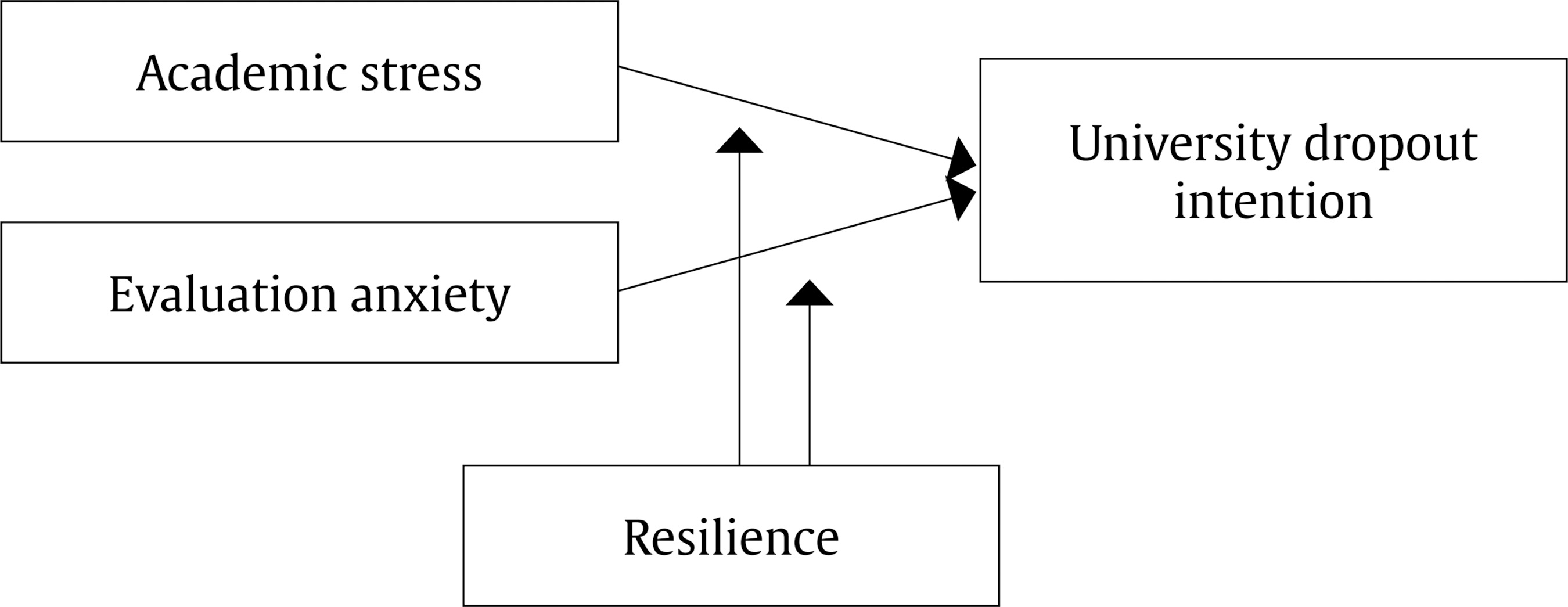

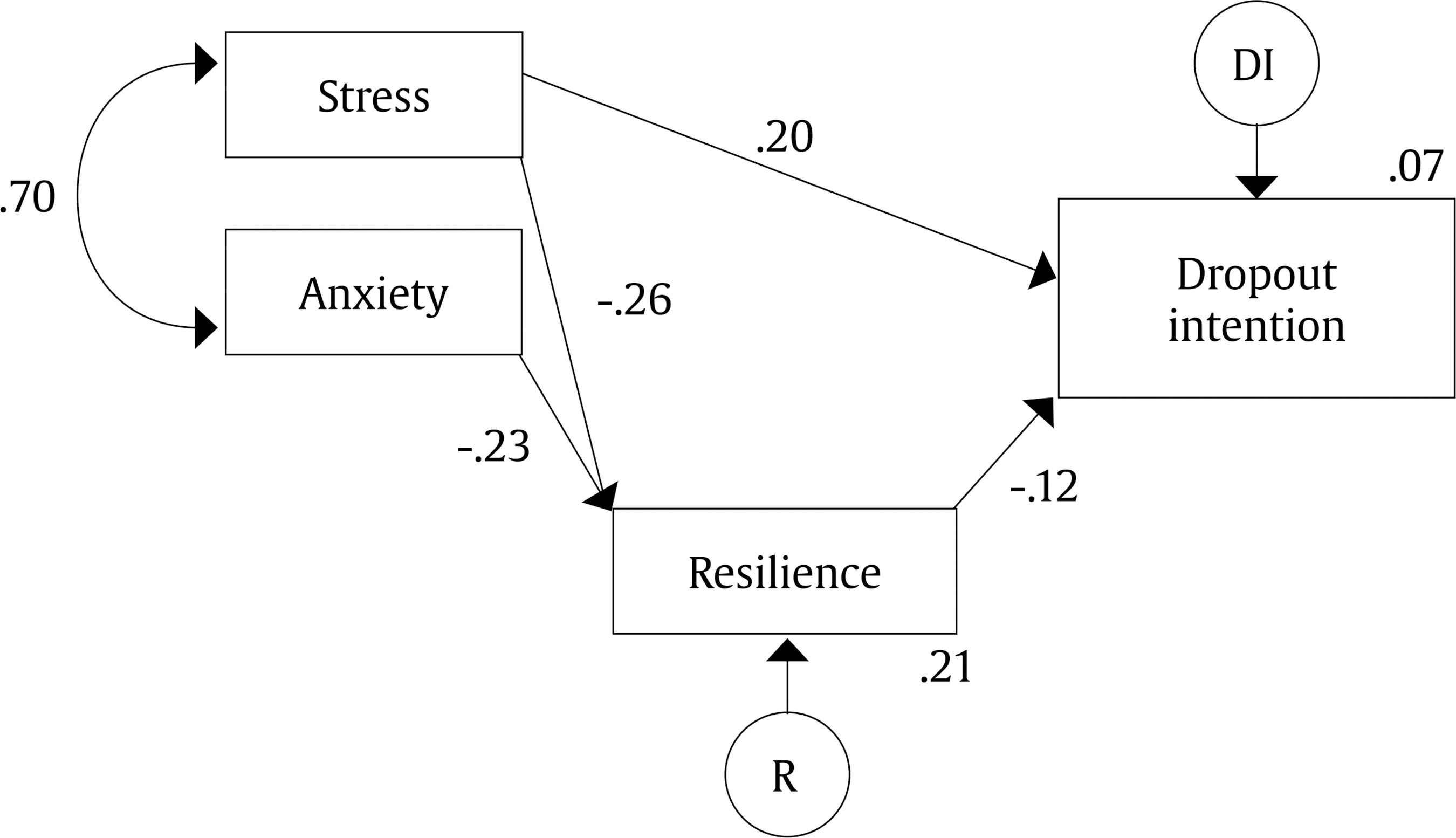







 e-PUB
e-PUB CrossRef
CrossRef JATS
JATS




